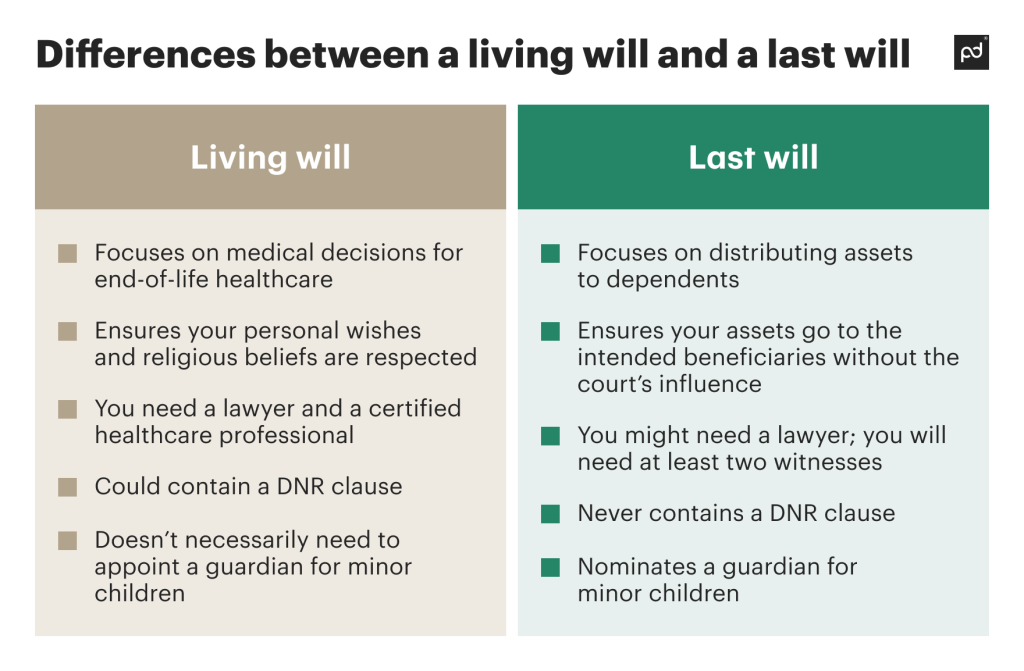With death being the only certainty besides taxes, you need a living will or last will to plan your estate.
But there is a slight difference between the two: a living will outlines how your assets will be shared if you become incapacitated, while a last will helps in estate planning in case of your demise.
In this article, we’ll discuss the major legal and technical differences between a living will and a last will.
We’ll also show you how to draft a will using a digital solution.
Key takeaways
- A living will is a legal document that specifies the healthcare directives for your end-of-life period or in the event that you’re unable to make decisions for yourself.
- Your last will and testament outlines how your assets should be distributed between family members, NGOs, charities, or other beneficiaries after your death.
- Dying without a will leaves your estate under the control of the court, which could lead to protracted legal battles.
- Combining both the living and last wills guarantees a hitch-free end-of-life care that doesn’t involve the courts.
What is a living will
A living will is a legal document containing your wishes in case you are no longer able to carry out your familial or professional responsibilities.
The universal application of a living will is in cases of life-threatening injuries or ailments that render the person unresponsive.
How does a living will work
If the testator of the will is on life support or enters a vegetative state, the living will document can act as their mouthpiece.
It specifies the kind of medical care they want or outrightly reject.
For instance, the living will could place a blanket ban on CPR, life support, and other life-sustaining measures — this is called a DNR (do not resuscitate).
Alternatively, the testator could specify the dependent (in places where euthanasia is legal) to help them transition to the next stage.
Living wills are also called advance directives — they provide instructions based on government-approved legal grounds.
They could also give a power of attorney to someone else to act on the testator’s behalf.
What is the last will
The last will and testament is a legal document that instructs your lawyers and loved ones on how to distribute your assets.
This document instructs the will’s executor whether to leave the assets to charity or their dependents.
It is the primary document in estate planning under the supervision of a probate court.
What are the differences between a living will and a last will
Although living and last wills are meant to handle your estate in your absence, both legal documents have some striking differences:
- Content: The living will focuses on your healthcare needs and medical decisions when you are nearing an end-of-life scenario. A last will focuses on your wishes after your death.
- Purpose: The last will ensures your assets go to the intended recipients and dependents without intervention from local courts, while your living will makes sure you get the medical care that aligns with your personal and religious leanings.
- Signatories: You need to sign your last will and testament in the presence of two witnesses. For living wills, a medical professional (usually your GP) should be one of the signatories or witnesses.
- DNR clauses: A living will could contain a DNR (do not resuscitate) provision, but last wills won’t contain this clause because the person is presumably dead.
- Minor protection: Your last will nominates a guardian for any of your children who are still minors. Your living will doesn’t focus on minor dependents.

Should you get a will or a living will
People who die intestate — without an enforceable will — are subject to intestacy laws.
So, getting a will keeps the state out of your personal and family business as much as that’s possible in modern society.
You want to plan your estate and end-of-life healthcare on your own terms. Let’s use two examples to explain why both living and last wills are necessary.
Following Jimi Hendrix’s demise in 1970, his surviving siblings and former band mates went into an acrimonious battle over his estate.
Since Jimi did not leave a last will, the court had to intervene.
When Terri Schiavo went into a coma, her partner requested the feeding tube be removed according to her wishes.
But since Terri didn’t express this in her living will, her parents contested this decision.
This dispute escalated into the public sphere, necessitating government intervention and turning an intimate family moment into a voyeuristic spectacle for the public.
So, our suggestion would be to have both a living will and a last will to cover all possible scenarios and healthcare decisions.
Challenges of having a last or living will
One reason people opt out of wills is that they assume the probate process is tedious and expensive.
Here’s the thing: the probate process will happen whether or not you have a will, with the court acting as the arbiter if no will is present.
And this may be the exact opposite of what you want for your loved ones in your absence.
Apart from that, going through the courts involves legal fees and government meddling in your personal affairs.
However, it needs to be underscored that, without a will, the government will also be making decisions on your behalf regarding anything you’ve left behind.
Furthermore, once the will goes through, it becomes a public record and easily accessible to anyone interested.
This may expose intimate personal health details.
Minors cannot have a will unless they are married. This usually leads to conflict between the guardians of deceased child stars and influencers.
If the beneficiary of a will is a minor, they wouldn’t be able to access the funds until they turn 18.
So you’d have to open a revocable living trust and assign a trustee to manage it until then.
Even with a last will, you won’t be able to distribute jointly-owned assets to dependents without express permission from other stakeholders.
This leads to contract disputes and recurring conflicts.
Most importantly, keeping track of the state law regarding end-of-life care can be difficult.
So, you’d need to update your living will to align with any new legislation.
Best tips for writing a will
Here are the best practices for creating valid living and last wills.
- Hire a financial advisor to evaluate your assets. They’ll help you understand how to distribute your financial and real estate assets amongst your dependents. Your financial advisor will also come in clutch when it comes to joint ownership and partnerships.
- Draft the will with a certified lawyer. These experts will give you legal advice for end-of-life care and estate planning in accordance with state law.
- Appoint an executor (usually your lawyer) to be in charge of handling the stipulations of the will.
- Appoint a healthcare agent to cosign your living will and ensure you get the desired care you stipulate should you become unresponsive.
- If you have a minor, appoint a guardian and establish a living trust for them.
- Combine both living and last wills. This will make your transition smooth and iron out all possible legality issues resulting from difficult decisions.
- Use ready-made will templates to eliminate the stress of drafting everything from scratch.
Create an enforceable will with PandaDoc
Drafting and signing legally binding living wills and last wills will take your end-of-life care and distribution of assets out of the hands of the government.
It will also guarantee your wishes are front and center even when you are incapacitated or deceased.
That’s why you need a digital solution to help you draft and sign your will in a few minutes.
Here are the steps to follow to make a will:
- Get a template for a living will or last will.
- Add your full legal name and address.
- Mention how you want your physical and financial assets to be distributed among your chosen beneficiaries.
- Sign the will in the presence of two witnesses (non-beneficiaries).
- Specify your health care power of attorney and executor of your will.
- Make codicil provisions to allow changes by the executor.
- If necessary, notarize the will. You can do that in person or remote using a digital solution like PandaDoc Notary.
- Send a copy to your estate planning attorney or executor for compliance review.
- Send the final draft of the will to the probate court — or let your personal representative handle the legal proceedings.
PandaDoc’s document management solution can serve as your estate planning tool because it contains living will templates that meet all compliance standards.
You can also edit and customize a last will template according to how you want your available assets distributed amongst the surviving family members.
Use the eSignature solution to sign and assign signature fields to witnesses, co-signatories, and power of attorney.
This will leave a digital trail of anyone accessing the document.
You can also store all estate planning documents on your PandaDoc dashboard for your peace of mind.
To find out more about PandaDoc, visit the learning academy or book a demo.
You can also start your 14-day trial right now.
Disclaimer
PandaDoc is not a law firm, or a substitute for an attorney or law firm. This page is not intended to and does not provide legal advice. Should you have legal questions on the validity of e-signatures or digital signatures and the enforceability thereof, please consult with an attorney or law firm. Use of PandaDoc services are governed by our Terms of Use and Privacy Policy.


